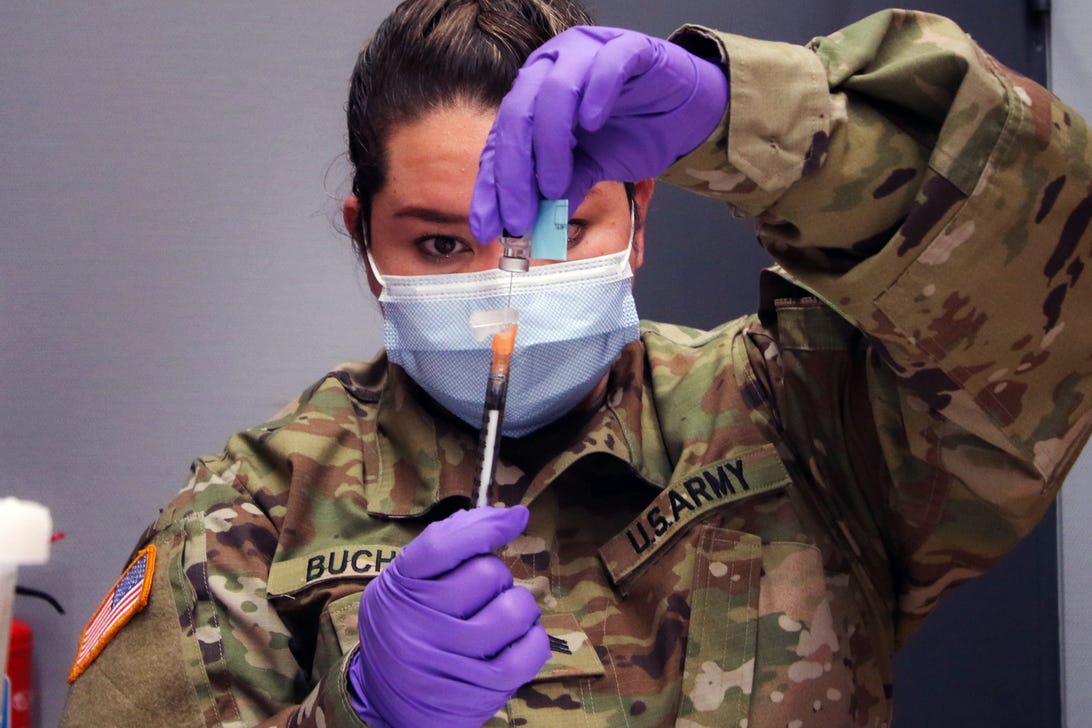
The Army’s COVID vaccine entered clinical human trials in March 2021.
Marcy Sanchez/US Army
For the most up-to-date news and information about the coronavirus pandemic, visit the
WHO and
CDC websites.
White House Chief Medical Adviser Dr. Anthony Fauci recently underscored the government’s investment in a universal COVID-19 vaccine that could successfully combat all variants. In an interview with NBC Thursday, Fauci said there was a concerted effort to develop a universal COVID vaccine that “would mean that the initial vaccination would cover all of these little variants, so you wouldn’t have to worry.”
“We want a pan-coronavirus vaccine so that you have it on the shelf to respond to the next viral pandemic,” Fauci said. “Ultimately, you want to get a vaccine that covers everything.”
That dream of a universal vaccine is exactly what researchers at the US Army’s Walter Reed Army Institute of Research (WRAIR) have been working on for most of the past year. In December, the US Army announced that its pan-coronavirus vaccine, the spike ferritin nanoparticle COVID-19 vaccine (aka SpFN) had completed Phase 1 of human trials with positive results.
Dr. Kayvon Modjarrad, director of infectious diseases at WRAIR and co-inventor of SpFN, told Defense One, “We’re testing our vaccine against all the different variants, including omicron,” the strain causing breakthrough infections, even in people who have received booster shots.
SpFN still needs to undergo Phase 2 and 3 human trials, though, to test its efficacy and safety in comparison to current treatments, Modjarrad said.
We’ll share what we know about the Army’s COVID-19 vaccine, including how it works and when it could become available.
For more, here’s what we know about the omicron variant today and the evolving definition of what it means to be “fully vaccinated” against COVID-19.
What is the US Army COVID-19 vaccine?
The three vaccines authorized right now for use in the US take two approaches to preventing COVID-19 infection: The Pfizer and Moderna vaccines use mRNA to build up immunity, while the Johnson & Johnson vaccine uses a harmless rhinovirus to train the body’s immune system to respond to COVID.
The Spike Ferritin Nanoparticle COVID-19 vaccine, or SpFN, takes a third approach, using a harmless portion of the COVID-19 virus to spur the body’s defenses against COVID.
SpFN also has less restrictive storage and handling requirements than the Moderna and Pfizer vaccines, allowing it to be used in a wider variety of situations. It can be stored between 36 and 46 degrees Fahrenheit for up to six months and at room temperature for up to one month, according to military scientists. Pfizer’s vaccine requires an ultracold freezer (between minus 112 and minus 76 degrees F) for shipment and storage and is only stable for 31 days when stored in a refrigerator.
The Army’s vaccine has been tested with two shots, 28 days apart, and also with a third shot after six months.
Will the Army vaccine work against different strains of COVID-19 like omicron and other coronaviruses?
SpFN is being tested in humans against the omicron variant, according to Modjarrad, and has shown positive results.
The vaccines from Moderna, Pfizer and Johnson & Johnson all target the specific virus — SARS-CoV-2 — that causes COVID-19. But Army scientists designed their vaccine to be “pan-coronavirus,” meaning it could protect against future strains of COVID as well as other coronaviruses.
The Army’s SpFN vaccine is shaped like a soccer ball with 24 faces. Scientists can attach the spikes of multiple coronavirus strains to each of the different faces, allowing them to customize the vaccine for any new COVID variants that arise.
“The accelerating emergence of human coronaviruses throughout the past two decades and the rise of SARS-CoV-2 variants, including most recently omicron, underscore the continued need for next-generation preemptive vaccines that confer broad protection against coronavirus diseases,” Modjarrad said in a statement last month. “Our strategy has been to develop a ‘pan-coronavirus’ vaccine technology that could potentially offer safe, effective and durable protection against multiple coronavirus strains and species.”
When will the Army’s COVID vaccine be available?
No date has been set. SpFN successfully completed animal testing and wrapped Phase 1 of human trials in December, but it must still complete Phases 2 and 3 of human testing, when its safety and efficacy is compared to current vaccine options.
Normally, completing all three phases can take up to five years, but the urgency of the COVID-19 pandemic is speeding up the process. The Moderna, Pfizer and Johnson & Johnson vaccines, for example, were tested, reviewed and authorized by the Food and Drug Administration over the course of one year.
What happens next with the Army SpFN vaccine?
After data from the Phase 1 human trials is collected, analyzed and published, Phase 2 and 3 trials will begin. There is very little information so far on when or how those trials will proceed or if the phases will overlap.
To follow the progress of the Army vaccine trials, visit the SpFN COVID-19 Vaccine Tracker provided by the US Army Medical Research and Development Command.
For more on COVID-19, here’s what we know about how the CDC defines being fully vaccinated, how to store your vaccine card on your phone, and what we still don’t know about the virus after two years.
The information contained in this article is for educational and informational purposes only and is not intended as health or medical advice. Always consult a physician or other qualified health provider regarding any questions you may have about a medical condition or health objectives.
